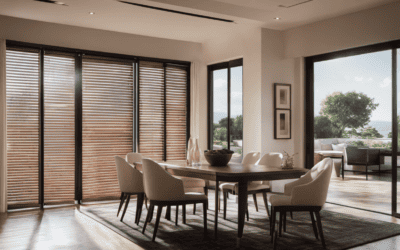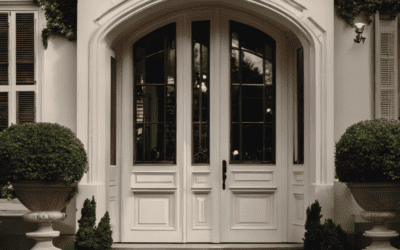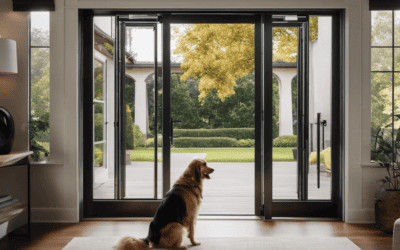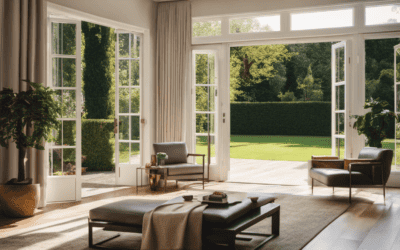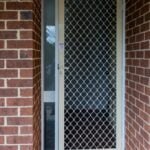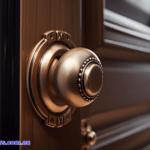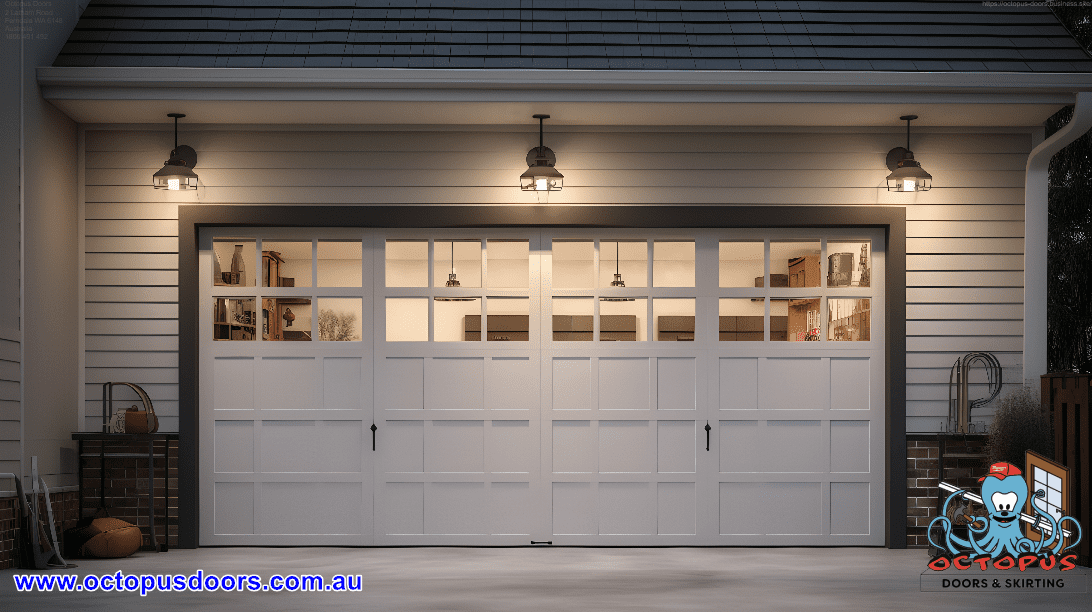
Yes, you can replace your garage door with French doors, but it necessitates obtaining permission from authorities and making some structural adjustments. First and foremost, you must reach out to your local planning and building authority to learn about the necessary procedures and obtain the required permits before beginning any work.
Step-by-Step Guide to Replacing a Garage Door With French Doors:
- Remove the existing garage door. Carefully detach the existing garage door to prepare for the installation of the French doors.
- Install pre-hung double panels. French doors typically come in pre-hung double panels that can easily replace your old garage door.
- Frame the new opening. The new opening may require framing to ensure a tight surround. Leave enough room for the door to move freely while keeping the structure secure.
- Make structural adjustments. Depending on the structure of the existing garage door, you may need to modify the framework to accommodate the French doors.
French doors offer a secure option for garage door replacement and grant easy access for moving furniture and equipment in and out of your home. Plus, they lend a polished look to the room. To guarantee a flawless installation and that your French doors are secure, hiring professionals for the job is highly recommended.
To sum up, replacing a garage door with French door is feasible as long as you obtain the necessary permits and make the appropriate structural modifications. For optimum results and to ensure your new doors are secure, don’t hesitate to enlist the help of professionals.
Can I change my garage door to a standard door?
Yes, changing a garage door to a normal one is possible, but there are some factors to consider, like the opening size, framing, insulation, and installation costs. Converting a garage door may seem like a daunting task, but with the right approach and professional help, it can significantly improve the functionality and aesthetics of your space.
Important Considerations for Garage Door Conversions:
Size and layout: The opening in the garage wall may require modifications to accommodate a standard-sized door. With a variety of door styles and sizes available, it’s crucial to measure the opening and choose a door that best suits your garage and your budget.
Framing and insulation: These elements in the garage need to be altered to fit the new door, potentially increasing costs.
Door type and style: It’s essential to match the door with the design of your home. Architect Peter Eisenman once said, “Architecture is not about form. It is about the coherence between form and content.” So, aim for a door that complements your home’s architectural features, materials, and colours.
DIY vs. professional help: While some homeowners may opt to install the door themselves, professional assistance is often necessary for proper fitting, insulation, and securing. Installation costs can range from $100 to $200 for removing and disposing of the old garage door and another $100 to $500 for professional installation of the new one.
Renowned designer Nate Berkus mentions, “Your home should rise up to greet you.” This simple yet powerful statement alludes to the importance of a well-designed space that caters to one’s needs. Converting your garage door to a conventional one elevates your home’s exterior design, creating a cohesive and welcoming space.
Can I remove my garage door and replace it with a window?
Removing a garage door and replacing it with a window is entirely possible, adding a stylish touch to your home’s exterior. This transformation enhances curb appeal and offers valuable benefits beyond basic utility. Let’s delve into the key aspects and essential steps to achieve this transformation smoothly and effectively.
Removing a Garage Door Window
- Remove screw caps and screws.
- Use a drill to remove screws from around the window trim.
- Utilize a flat tool, like a putty knife, to remove one side of the insert.
- Remove the other side of the insert.
Replacing a Garage Door Window
- While a helper holds the outside window frame, remove screws from the inside retainer.
- Pull the inside retainer out of the door.
- Carefully remove any broken or old glass.
- Insert the new glass panes into the window frame.
- Reinsert the screws into the inside retainer, ensuring the helper holds the outside window frame in place.
Alternatively, if you prefer a slightly different method:
- Remove screw caps and screws.
- Use a drill to remove screws from around the window trim.
- Utilize a flat tool, like a putty knife, to remove one side of the insert.
- Pry the window trim off the window with a flathead screwdriver or another flat tool.
- Remove screws from the other side of the insert.
- Pull the window out of the garage door carefully.
Remember that replacing garage door window inserts is similar to replacing standard windows. To successfully complete the project, you need to order new windows, plan the replacement process, and then carry out the actual replacement.
By following these steps, you can enhance the look of your garage door with a fresh, sophisticated touch.
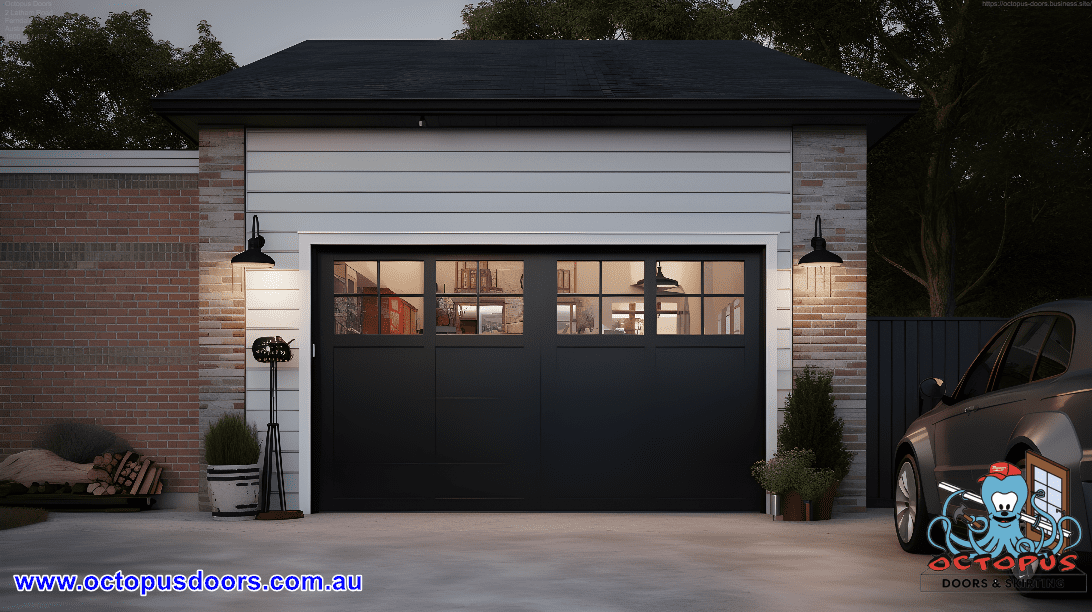
Do I need planning permission to change the garage door to French doors or replace a door with a window?
Yes, obtaining permission from your local city authority is necessary; however, specific requirements may vary. Upgrading your garage may seem simple, but did you know there are rules and regulations to follow?
According to Garage Storage Lab, seeking permission from your local city authority is essential before proceeding with any modifications. On the other hand, MyBuilder suggests that planning consent may not be required for changing garage doors, provided the work is carried out by a competent registered contractor. Upon completing the job, this professional must issue a certificate or apply for a building regulation notice and get the work signed off.
To ensure you comply with local regulations, follow these key steps:
Consult your local city authority – They will provide accurate, up-to-date information on requirements and restrictions. Don’t hesitate to ask questions; being safe is better than sorry.
Hire a registered contractor – Select a reputable, experienced professional to carry out the work, ensuring it meets building standards.
Secure the necessary certificates – Once the project is completed, obtain the required certification proving compliance with regulations.
Stay informed on industry trends – Home improvement regulations can change over time, so keep an eye on local laws to remain compliant in the future.
Remember, it’s always recommended to consult with both your local city authority and a registered contractor to ensure that all aspects of the installation adhere to regulations, guaranteeing a successful project outcome.
Given the complexities and regulations surrounding home improvement projects, have you considered seeking expert advice before replacing your garage door with French doors? Properly understanding the planning permission requirements allows you to prevent any issues and enjoy your new, stylish garage entrance.
Do I need permission to put in French doors?
In Australia, installing French doors may require permission depending on the installation type. For instance, adding French doors to an existing opening typically doesn’t necessitate formal consent. However, if the installation involves creating new openings through an extension, the size and scale of the addition will dictate what’s allowed under Permitted Development (PD) rights.
When installing French doors in a garage used solely for storage and not as a habitable room, there’s no need for planning permission or building regulations. Nevertheless, it’s wise to consult an experienced and reputable installer who specializes in replacing and installing new patio doors.
Keep in mind regulations and requirements for French door installations can vary based on location and installation circumstances. As such, it’s prudent to check with the local council or a qualified professional to ensure compliance with all relevant regulations and requirements.
Optimizing your home with French doors? Consider these essential points for a smooth installation process:
- Analyze the installation type – Does it involve adding to an existing opening or creating new openings?
- Assess the need for permission – Based on installation type, determine whether permission or planning consent is required.
- Consult professionals – Seek advice from experienced installers or qualified experts regarding installation and regulations.
- Contact local authorities – Confirm specific requirements and compliance with local council regulations.
Can you install French doors to open out?
Installing French doors that open out to your garage in Australia is feasible, but you must adhere to specific fire safety regulations and protocols. The critical connection between your house and garage, known as the garage entry door, must conform to the International Residential Code (IRC) requirements. Let’s break down these requirements to help you ensure your French doors are compliant and fire-rated.
First and foremost, your garage entry doors must be crafted from specific materials, such as solid wood or metal, to meet fire safety standards. These materials provide enhanced protection against the rapid spread of fire, safeguarding your household.
In addition to material considerations, your French doors must also be self-closing – a crucial feature outlined by the IRC. This means you may need to install a door closer or an automatic door-closing mechanism to guarantee compliance.
However, there’s one restriction you must be mindful of: IRC requirements dictate that garage entry doors cannot open into a bedroom. Keep this in mind while planning the installation of French doors that open out onto your garage.
By diligently following these guidelines, you can enhance your home’s aesthetic appeal with French doors, all while ensuring top-notch fire safety and complying with relevant Australian regulations.
How much does it cost to replace a garage door with French doors?
Replacing a garage door with French doors in Australia typically costs between $400 and $5,500, depending on factors such as door type, location, customization, and materials used. It is crucial to obtain permission from local city authorities before undergoing this transformation.
Cost Factors for French Door Installation
Door Type: French doors are available in various designs and materials, directly impacting their price. For a basic, low-end French door, you may only spend around $400-$500; however, custom-designed doors can exceed $4,000.
Location: The installation cost may vary depending on where you live in Australia. These fluctuations can contribute to local labour rates, regional material pricing, and transportation expenses.
Customization: Personalizing your French doors with intricate designs, windowpanes, or unique colours will significantly increase their overall cost.
Materials used: The choice of materials, such as wood or aluminium, will directly affect the price. High-quality materials usually come with a higher price tag.
Labour and Insulation: Additional costs, such as labour for installation and adding insulation to maximize energy efficiency, will also influence the final expense.
Expert Insight: This Old House reports that replacing an existing garage door in the US ranges from $700 to $2,500, with French-style garage doors costing approximately $2,000 to $5,500.
To sum it up, expect the cost to replace a garage door with French doors in Australia to vary based on your choice of door, location, and personal preferences.
How to convert a two-door garage into a one-door garage?
Converting a two-door garage into a one-door garage requires removing the two single doors and installing a new double door at an average cost of $3,000. The process can vary, with prices as low as $950 or as high as $8,000, depending on factors like material, brand, and the involvement of a structural engineer. Keep in mind that this is not a DIY project – it’s advised to work with a local garage door installation professional to ensure a smooth and successful conversion.
Step-by-Step Guide for Two-Door Garage Conversion
- Measure the garage – This is the starting point for your project. You need to ensure that your desired double door will fit properly.
- Select a double garage door – Choose a replacement double door that meets your specifications, considering material, brand, and design factors.
- Remove the garage pillar – This structural change is necessary to accommodate the new double door. Be sure to consult with a structural engineer if needed.
- Discard the two single garage doors – As you’ll no longer be using them, removing the old doors safely and efficiently from the premises is essential.
- Install the new double door – Enlist the help of a garage door installation professional to ensure proper installation, safety, and functionality.
- Add the final touches – Finish the project with any necessary painting, sealing, or other aesthetic enhancements.
Quick Tip: Labor costs for converting two single garage doors to one typically range from $300 to $575, so be sure to factor this into your overall budget.
As you embark on this project, remember to ask yourself key questions like, “Which double garage door fits my needs and aesthetics? What materials and design options are available within my budget?” By considering these factors and working with professionals to ensure a seamless conversion, your two-door garage can become a functional and visually appealing one-door garage.
Can I convert my detached garage into a guest room?
Converting a garage into a room can provide additional living space, with costs ranging from $6,000 to $19,000. However, it’s crucial to consider various factors before starting this project – including its impact on property value, space usage, and compliance with local building codes. This article will explore the key aspects and important steps related to garage conversions, ensuring a successful and rewarding outcome.
Cost & Property Value
The conversion cost depends on the garage size and the project scope. Remember that this investment might affect the home’s marketability, positively or negatively, depending on factors such as location and buyer preference.
Storage Options
Before proceeding, ensure that all items currently stored in the garage have alternative storage space – either in a basement, attic or a separate storage facility.
Natural Light & Ventilation
One fundamental consideration is the amount of natural light and ventilation the new room will receive. Adding windows can significantly improve both aspects, making the converted space more comfortable and inviting.
Drywall & Ceiling Height
A garage conversion usually requires drywall installation and adherence to building codes regarding ceiling height standards. Ensure your project meets these requirements to avoid potential issues with local authorities.
Insulation & Ventilation
Proper insulation and ventilation are essential to maintain comfortable room temperatures and prevent potential issues such as mould growth. Work closely with a professional to guarantee these aspects are adequately addressed in your garage conversion.
Permits & Approvals
Don’t forget about obtaining the necessary permits and approvals from your local municipality before starting any work. This step will help prevent future complications and ensure your project is legally compliant.
Weighing the Pros & Cons
While garage conversions offer many benefits, such as rental income opportunities and extra living space, there are downsides to consider – including the loss of storage space and the time and effort required to secure permits. It’s essential to analyze and weigh all aspects before embarking on this project to make an informed decision that suits your needs and budget.
In conclusion, garage conversions can be a great way to add living space and value to your home, but addressing key factors and steps involved in the process is essential. By considering these aspects and thoroughly planning your project, you’ll be well on your way to creating an enjoyable and functional space that meets your needs and enhances your property’s appeal.
Do you have to raise the floor in a garage conversion?
Yes, you may have to raise the floor in a garage conversion to ensure proper insulation, damp-proofing, and compatibility with your home’s existing floor level. A garage conversion involves multiple key aspects and important steps, which we will examine to help you in your project.
First and foremost, insulation is a critical consideration. Keep in mind that your garage wasn’t built for habitation, and as a result, it may lack sufficient insulation. Raising the floor can incorporate the necessary insulation material to achieve optimal indoor temperature and energy efficiency. Don’t overlook the importance of using high-quality insulation material, as it will pay off in the long run by saving on energy bills.
Secondly, damp-proofing cannot be ignored. One of the challenges of converting a garage is dealing with potential dampness issues. Elevating the floor allows you to install a damp-proofing solution effectively, preventing moisture from seeping in and providing a comfortable living space.
Moreover, it’s crucial to ensure your garage conversion’s floor is aligned with the existing floor level of your home. By raising the floor to match the height of the adjacent living spaces, you can create a seamless flow between areas, improving overall aesthetics and making it easier to move from one section to another.
What steps should you take to raise the floor?
Evaluate the existing concrete slab: Inspect the current floor for cracks or damages before considering any modifications. Consult with a structural engineer to verify whether raising the floor is necessary and safe.
Determine the desired floor height: Measure the difference in floor levels between your garage and the rest of your home to determine the necessary height.
Select appropriate materials: Choose suitable damp-proofing membrane and insulation materials to meet the requirements of your specific garage conversion.
Hire experienced professionals: Work with licensed and insured contractors to ensure proper installation and compliance with local building regulations.
Obtain necessary permits and approval: Check your local area’s building codes and regulations, and obtain the required permits before commencing with the project.
In conclusion, while raising the floor in a garage conversion may demand additional investment, it’s crucial to prioritize insulation, damp-proofing, and alignment with your home’s existing floor level. By carefully considering these factors and following the essential steps outlined above, you’ll achieve a successful and cozy garage conversion that adds value to your property.
How long does a garage conversion take?
A typical garage conversion project takes between 2 and 6 weeks to complete, but this can vary depending on factors like garage size, project scope, and permitting. As Home improvement expert Bob Vila states, “The construction portion of a garage conversion typically lasts between 2 and 6 weeks.” While some experienced contractors may be able to finish in just a few days, most projects fall within the one to the four-week range.
Important Factors Affecting Garage Conversion Duration
- Securing a contractor: Finding a suitable contractor plays a significant role in the timeline. During peak construction season, professionals may be booked out for extended periods, delaying your project.
- Obtaining building permits: Acquiring the necessary building permits can affect the overall timeline, as the process can sometimes take longer than expected.
- Garage condition: If the garage is in poor shape, additional repairs or replacements may be necessary, which could extend the project duration.
According to Maxable Space, a leading garage conversion consultancy, conversions can be much faster if the garage is in good condition, taking around seven to nine months in total. However, if the framing, foundation, siding, or roofing is degraded or not up to code for a habitable dwelling, it will need to be repaired or replaced, which adds time to the project.
In conclusion, while garage conversion projects generally take between 2 and 6 weeks for the construction portion, securing a contractor, obtaining permits, and the garage’s initial condition can all influence the overall timeline. By keeping these factors in mind and enlisting the help of seasoned professionals like Bob Vila or Maxable Space, you can ensure your garage conversion experience is efficient and successful.
From Ordinary Doors to Elegant French Doors
Replacing a garage door with French doors can be a stylish and functional upgrade to any home. Not only will this transformation enhance your property’s curb appeal, but it will also provide increased natural light and accessibility. Before embarking on this project, it’s essential to consider factors like structural integrity, insulation, and security. Working with experienced professionals and carefully planning the process can create a stunning, practical space that seamlessly blends indoor and outdoor living. Embrace the elegance of French doors and unlock your garage’s full potential today.
Related Articles:
How Much Does a French Door Weigh
Did you know that the average weight of a French door is around 150 pounds? That's a significant weight when selecting and installing these beautiful doors. Due to size, materials, and hardware, French doors can vary in weight. It's crucial to carefully check the...
What Are the Best Blinds for French Doors
We've all been there - standing before our French doors, searching for the perfect blinds that balance privacy, light control, and style. Well, look no further! In this article, we'll guide you through the best blinds for French doors, ensuring you find the perfect...
How to Remove Grids From French Doors
We know how frustrating it can be to have grids on your French doors, making them feel outdated and restricting the view. But fear not because we're here to help! In this article, we'll guide you through safely removing those grids, giving your doors a fresh, modern...
Do French Doors Need Astragal
So, you're considering French doors for your home, and you've heard something about astragals. Well, let us tell you, they can make a difference! Astragals are these nifty little components that offer many benefits, like weatherproofing, added security, and noise...
Ideas for Keeping French Doors Open
Are you tired of your French doors constantly slamming shut? Well, we've got some game-changing ideas for you! Picture this: your elegant French doors gracefully open, inviting in a gentle breeze and allowing sunlight to flood your space. With our innovative...
Soundproof Panels for French Doors
We've all experienced the frustration of unwanted noise infiltrating our homes through French doors. But fear not because we have the solution: soundproof panels. These panels minimize noise intrusion and create a more peaceful environment. When selecting panels for...
Can You Get Aluminium French Doors
So, you're in the market for a new set of doors, huh? Well, let us tell you about the wonders of aluminium French doors. These babies are durable and low-maintenance, but they also come with all the bells and whistles you could ever imagine. From energy efficiency to...
How Much Impact Pgt French Doors
We're here to talk about the impressive impact of PGT French doors. Did you know these doors are rated to withstand winds up to 150mph? That's right! With their laminated glass panes and foam frames, PGT French doors offer unparalleled protection against storm damage....
Dog Door Ideas for French Doors
Here at Dog Door Ideas for French Doors, we understand pet owners' struggle when trying to find the perfect solution for their furry friends. Did you know that French doors can provide a stylish and elegant look to any home? This article will explore various options...
Why Choose French Doors
When enhancing our homes, we all want the perfect balance of style, functionality, and natural light. That's why we believe French doors are an excellent choice. You might think, 'But aren't French doors more expensive and require more maintenance?' They come with...
Message Us
What Are the Feasibility and Benefits of Upgrading a Garage Door to French Doors for Renovations?
When considering renovations, upgrading a garage door to French doors can bring many benefits. Not only can it improve the aesthetic appeal of your home, but it can also increase natural light and energy efficiency. Additionally, some homeowners may qualify for a rebate on their renovations.
Get In touch below. Ask Any Question or Start a Free Quote
Call Us
1800 491 492
I'm James Davis, a carpenter with eight years of experience in carpentry services, repairs, installations, renovations, and maintenance of interior doors. I have a diploma in carpentry and joiner trade from the Education Skills Australia Institute and take pride in delivering high-quality results to ensure customer satisfaction. I'm a blog writer for Octopus Doors Company and enjoy sharing my knowledge and tips on maintaining security measures and choosing the right door materials, paints, or handle styles. I specialize in custom-made interior doors and strive to make every home look fabulous. Contact me anytime for help with door-related issues.


